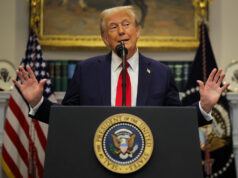China seen saving monetary stimulus for trade war winter as yuan weakens
CHINESE policy makers are holding back from rolling out the big guns of monetary stimulus, keeping options in reserve as the trade standoff with the US risks morphing into a global currency war.
The People’s Bank of China (PBoC) late Friday called for a “rational” view on current headwinds, signaling that the targeted approach to shoring up output would continue. Investment, retail sales and credit data due this week are expected to confirm the ongoing slowdown in the world’s second-largest economy.
Officials are sticking to a cautious monetary strategy even after tensions with the US worsened, with President Donald Trump’s accusations of Beijing’s currency manipulation adding sensitivity to any stimulus measures that would depress the yuan. At the same time, the weakening of the currency past 7 per dollar removes one barrier for a cut to interest rates should the trade war deteriorate to the point where stronger action is needed.
“Policy makers are fine with the current state of the economy,” said Larry Hu, head of China economics at Macquarie Securities Ltd. in Hong Kong. “But if growth continues to slow, at certain point, the priority will shift to growth stabilization.”
Former central bankers gathered for a policy symposium in the far North East warned Saturday that the confrontation with the US is deepening.
The US’ labeling of China as a currency manipulator “signifies the trade war is evolving into a financial war and a currency war,” and policy makers must prepare for long-term conflicts, Chen Yuan, former deputy governor of the People’s Bank of China (PBoC), said at a China Finance 40 meeting in Yichun, Heilongjiang.
Former PBoC Governor Zhou Xiaochuan called for efforts to improve the yuan’s global role to deal with the challenges of a dollar-denominated financial system.
The challenges aren’t just from the dollar. The International Monetary Fund said in its annual report on the Chinese economy released Friday in Washington that if the US escalates its current threat to add 10% extra tariffs on the remainder of its imports from China to 25%, growth would be trimmed by 0.8 percentage point, leading to “significant negative spillovers globally.”
It’s in that kind of scenario that China may be forced to turn to more aggressive monetary support, even in the face of rising domestic debt risks and asset price bubbles. Efforts to prop up growth have already propelled the stock of corporate, household and government debt to more than 300% of gross domestic product (GDP), according to an Institute of International Finance report last month.
Nevertheless, having allowed the yuan to weaken past 7 per dollar, the PBoC has freed itself from an artificial constraint that it has been bound by for years, allowing borrowing costs to be reduced further without — in theory — the need to prop up the currency.
So far, policy makers haven’t given any hint of changes to the 1-year lending rate which would affect the price of borrowing across the whole economy, or reducing the price of loans to banks in the wake of the US Federal Reserve’s latest cut. Instead, officials from PBoC Governor Yi Gang downward have signaled that an impending reform of the interest rate system could do the work of a rate cut, by transmitting policy more effectively.
In the meantime, China’s leadership appears to want to manage the economy’s long-term slowdown rather than arrest it, and smooth shorter-term weakness in consumption and output with about 2 trillion yuan ($283 billion) in tax cuts, as well as localized investment incentives.
An “objective and rational view” should be taken on those headwinds, the PBoC said in the report released Friday evening. The central bank should “stay confident, be focused, mind our own business,” and use a combination of tools to form new growth drivers, it said.
“Stability is still the focus with quality growth, and the employment market more important than GDP,” said Jeff Ng, chief Asia economist at Continuum Economies in Singapore. “China will allow a slowdown and is prepared to do so.” — Bloomberg



